
John Henry Mears, Broadway producer and globe traveling extraordinaire broke, not just one, but two circumnavigation records within his lifetime. A member of the Longines Honor Roll, Mears pushed the boundaries of travel and flight.
He set records, testing new navigational techniques and equipment, in order to to pave the way for trailblazers like Post and Gatty. His extraordinary commitment to global travel has contributed to the ease with which our modern society can traverse new lands.
The First Record
Born on May 22nd, 1878 in Massachusetts, Mears broke his first record at 36 years of age. Leaving New York City aboard the RMS Mauretania on July 2nd 1913, Mears travelled the world on a variety of yachts, steamers and trains.
After 35 days, 21 hours and 35 minutes Mears returned to that very same spot in New York City, a record breaking time that stood firm for 13 years. In 1913, the sun published Mears itinerary as follows:
- United States: New York City from the offices of the New York Sun newspaper on July 2, 1913
- Atlantic crossing: via the steamer “Mauretania”
- England: Fishguard, London & Dover via train
- France: Calais via channel steamer, Paris via train
- Germany: Berlin via train
- Russia: St Petersburg & Omsk via train
- China: Harbin, Manchuria & Mukden via train
- Korea: Pusan via train
- Japan: Shimonoseki via steamer & Tokyo via train
- Pacific crossing: via the steamer “Empress of Russia”
- Canada: Victoria, British Columbia where he left steamer en route and boarded a yacht. Left yacht en route and boarded a hydroplane
- United States: Seattle, Washington, St Paul, Minnesota, Chicago Illinois, Cleveland, Ohio & New York City back to the offices of the New York Sun newspaper via train.[1]
This was a breathless pace amounting to an extraordinary time, only broken by Linton Wells and Edward S. Evans in 1926. They used a variety automobiles, trains, planes and liners completing the journey in 28 days 14 hours and 36 minutes.
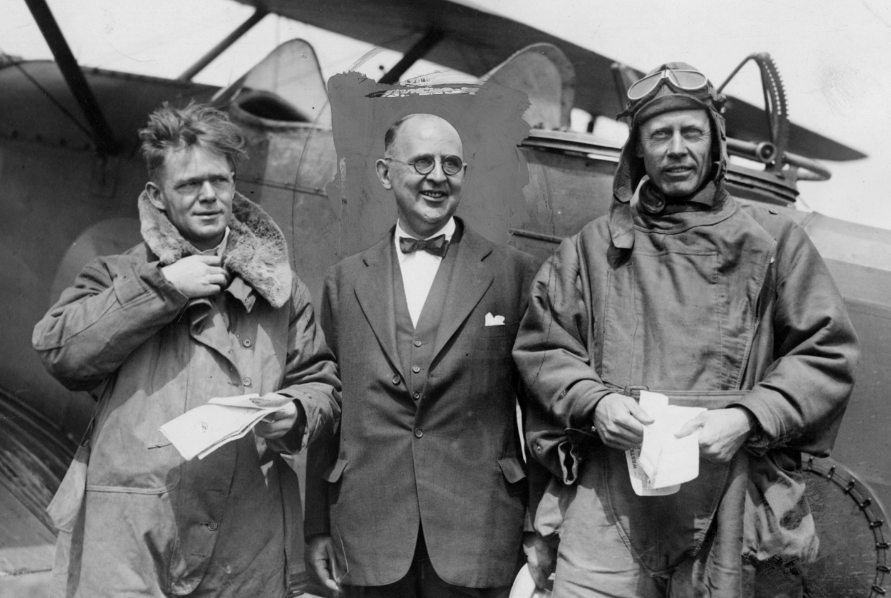
Wells and Evans time was one cut drastically from the days of Ferdinand Magellan who sailed the world in 3 years during the sixteenth century.
Then came Nellie Bly, the New York World reporter who took 72 days in 1889.
In 1924 U. S. Army planes would take 175 days, of which 15, were flying days.
These round the world journeys were gargantuan undertakings in both preparation, navigational study and execution. In areas that were rarely traversed, or entirely unknown, it was no simple task.
Discontented with a broken record Mears set out, once again, in 1928 to regain his title.

Mears spent several years preparing for this seminal journey, paying close attention to maps, technologies and navigational technique. He pioneered the early advent of global air travel when testing all this knowledge and planning in the cockpit.
Mears and Collyer
With pilot Charles B. D. Collyer and white Westie, mascot, Tail Wind in tow they broke the record with a time of 23 days, 15 hours and 21 minutes. So named their “race against the moon,” the journey was completed before a full lunar cycle.
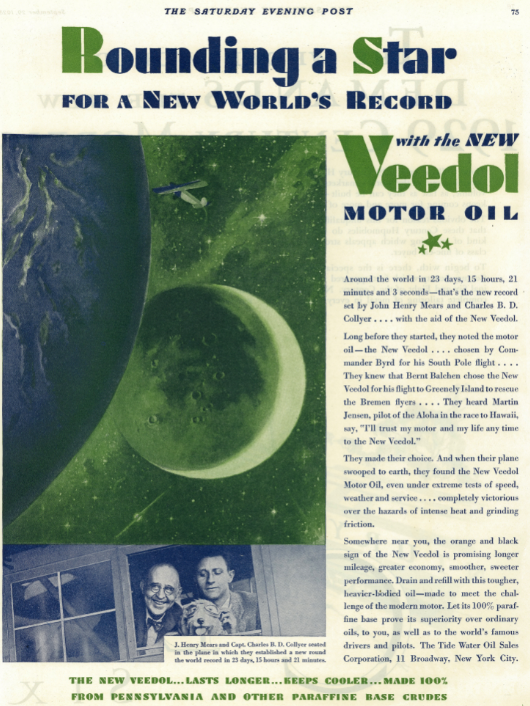
Equipped with special chronometers, Mears was among the first to experiment with, and problem solve, the issues surrounding correct timing and position. John P.V. Heinmuller writes:
For hundreds of years chronometers had been considered of importance principally to sea navigation, but these two record-breakers proved the worth of a good chronometer in air navigation. They understood how essential exact time knowledge was in wrestling with navigational problems.[2]

Mears thorough preparations set an excellent pace for both aviators and Westie.
They left Battery Seawall, New York in a seaplane on the morning of June 29th, 1928. Collyer and Mears aimed to speed past the express liner, Olympic which had stowed their Fairchild monoplane the day prior.
On reaching The City of New York, the Fairchild monoplane, their race with the moon had begun.
Upon landing at Cherbourg on July 5th they sped around the globe. This is the log kept by Mears:
- July 5: 9:45 P.M. arr. Cologne
- July 6: 4 A.M. lv. Cologne
- July 6: 1:45 P.M. arr. Berlin
- July 6: 5 P.M. arr. Koenigsberg
- July 7: 2 A.M. lv. Koenigsberg
- July 7: (afternoon) arr. Moscow
- July 7: 1:39 P.M. lv. Moscow
- July 7: 6:45 P.M. arr. Kazan
- July 8: 2 A.M. lv. Kazan
- July 8: (no time given) arr. Chita, Siberia, after brief stop at Krasnoyarsk
- July 9: 4 A.M. lv Chita
- July 10: arr. Mukden: off after brief stop
- July 11: 8:13 A.M. arr. Pingyang, Korea
- July 11: 9:10 A.M. lv. Pingyang[3]
From Pingyang they continued on to Tokyo, Yokohama, steaming out of Japan on the Empress of Britain and arriving in Victoria, Canada on July 20th. They flew on to Spokane, reaching Minneapolis on the night of July 21st.
They left the next morning for Miller Field, Staten Island, where they arrived on July 22nd, 6.55 P.M. Mears had covered 19,725 miles in less than 24 days, traveling faster than the moon around the earth.
Using their Fairchild monoplane, The City of New York, to such an extent; the journey was the first of its kind. Only broken by the German, Graf Zepplin, in 1929 with a time of 21 days, 8 hours and 26 minutes.
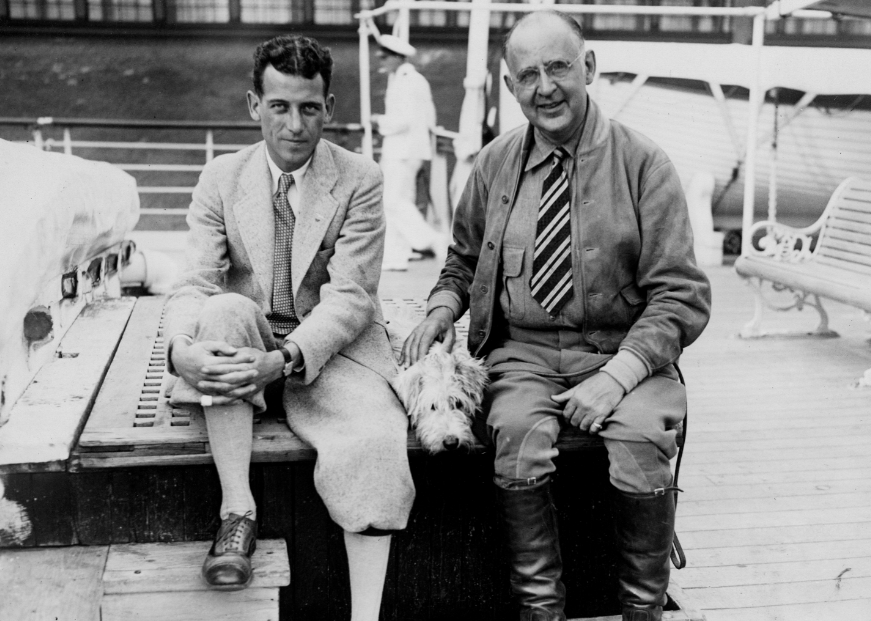
The hydrogen filled airship had beaten Mears record and he was not ready to sit idle. He set his sights upon circumnavigating the globe solely by plane. Thus followed Mears and Henry J. Brown’s 1930 attempt.
Mears and Brown
They spent months pouring over books, maps, pilot charts, and hydrographic charts, whilst gathering everything they could possibly need for a long distance flight.
On August 1st 1930, they were ready. Mears, Brown and mascot, Tail Wind II (the successor of Tail Wind, the original) climbed on board the aircraft.
Taking off from Roosevelt Field, they made a promising start, landing in record time at New York, Harbour Grace. It seems the lucky talisman, Mears terrier, had aided the flight thus far.
Their take off from New York, however, was disastrous. The plane veered off the runway, hit some rocks and was wrecked beyond repair. The two men were injured and taken to hospital.
Poor Tail Wind II ran away in fear and never returned. Mears and Brown were released from hospital the same day, neither seriously injured.
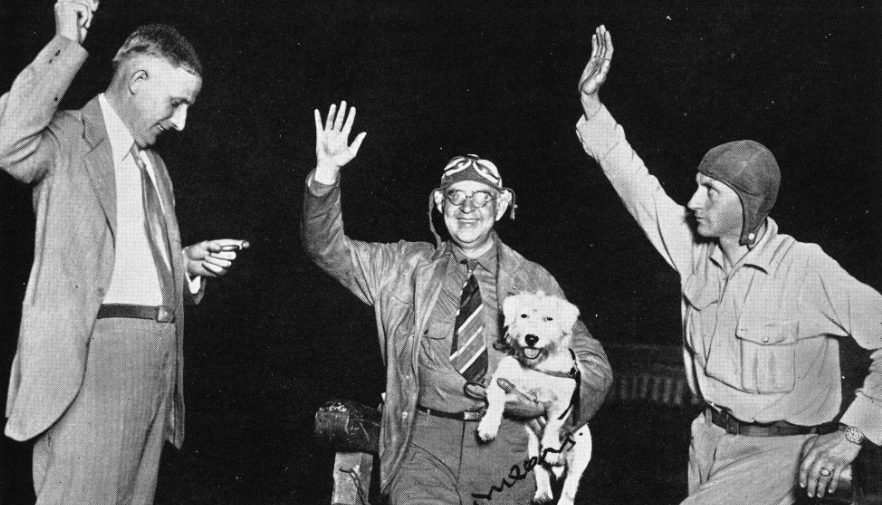
Mears did not make a second attempt at the journey, stepping back to let pioneering successors such as Wiley Post and Harold Gatty trail blaze onto the scene.
Mears paved the way for Gatty and Post’s record time of 8 days, 15 hours and 51 minutes. This was traveled entirely by plane, an extraordinary feat.
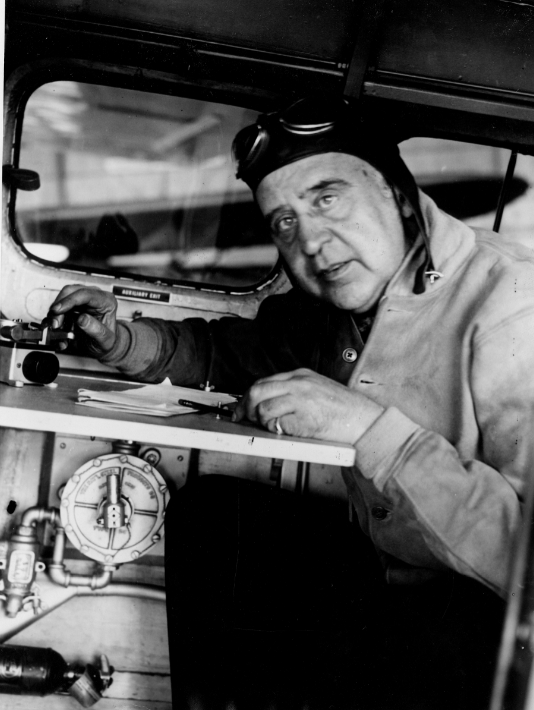
Howard Hughes, a few years later, went on to better this time with 3 days, 19 hours, 17 minutes.
The Virgin Atlantic Global Flyer now speeds around the world in 2 days 19 hours and 1 minute.
This record was set by Steve Fossett in The Scaled Composites Model 311 Virgin Atlantic GlobalFlyer, designed by Burt Rutan, in 2005.
We would not be able to travel toward distant lands with such speed or accuracy if it hadn’t been for pioneers like John Henry Mears.
Footnotes
- ‘John Henry Mears,’ Revolvy, (CC-BY-SA), http://broom02.revolvy.com/main/index.php?s=John%20Henry%20Mears&item_type=topic (date accessed: 27/08/16).
- John P.V. Heinmuller, ‘VIII John Henry Mears and Charles B.D. Collyer,’ Man’s Fight to Fly, (New York: Aero Print Company, 1945), pp. 129.
- John P.V. Heinmuller, ‘VIII John Henry Mears and Charles B.D. Collyer,’ Man’s Fight to Fly, (New York: Aero Print Company, 1945), pp. 128.
Bibliography
Anonymous ‘John Henry Mears,’ Revolvy, (CC-BY-SA), http://broom02.revolvy.com/main/index.php?s=John%20Henry%20Mears&item_type=topic
Heinmuller, John P.V. ‘VIII John Henry Mears and Charles B.D. Collyer,’ Man’s Fight to Fly, (New York: Aero Print Company, 1945).
[1] ‘John Henry Mears,’ Revolvy, (CC-BY-SA), http://broom02.revolvy.com/main/index.php?s=John%20Henry%20Mears&item_type=topic (date accessed: 27/08/16).
[2] John P.V. Heinmuller, ‘VIII John Henry Mears and Charles B.D. Collyer,’ Man’s Fight to Fly, (New York: Aero Print Company, 1945), pp. 129.
[3] John P.V. Heinmuller, ‘VIII John Henry Mears and Charles B.D. Collyer,’ Man’s Fight to Fly, (New York: Aero Print Company, 1945), pp. 128.
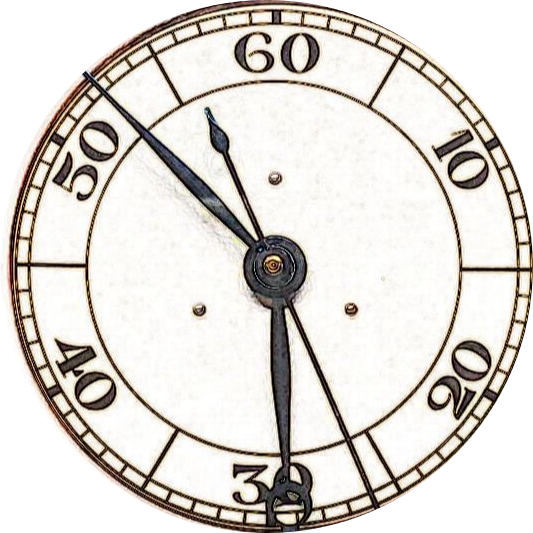
Hi,
It’s not Edward F. Evans with Linton wells
It’s Edward S. Evans (Edward Steptoe Evans)
Best regards
PG
Greetings and a very big thank you for the note. Andy 😉